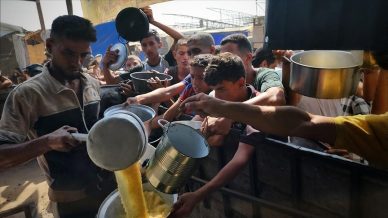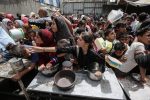GAZA, (PIC)
Khalil Al-Balaawi struggles to obtain two gallons of drinkable water after waiting in a long line at a water filling station in the Sheikh Radwan neighborhood in northern Gaza City.
The 18-year-old goes through this exhausting routine daily, spending two to three hours between waiting his turn and transporting water to a shelter.
Once the water arrives, his mother boils it to disinfect it, after her two children (ages 7 and 9) repeatedly suffered from intestinal infections due to water contamination.
The mother, who lost her husband in the war, says that obtaining water has become a huge challenge, not because it isn’t available or reaching the school where they have taken refuge, but because of the risks it poses. The water infrastructure is destroyed, and it’s contaminated with sewage and waste.
Khalil’s mother explains that disinfecting the water by boiling is no easy task. It requires keeping the fire burning for hours, which in turn demands more wood, especially since gas has been scarce since the start of the extermination war launched by the occupation over a year ago.
She and her older children are forced to take on this work. Otherwise, they would face the dire consequences of water contamination amidst a lack of medicine and the collapse of the healthcare system. Sometimes, the water arrives filled with impurities, which she filters using a shawl she has designated for this purpose.
With the ongoing siege by the Israeli occupation forces on northern Gaza, the issue of drinkable water has become even more critical. In Gaza City, many families struggle daily to secure even a single bucket of water, and the dream of safe, clean drinking water remains difficult to achieve.
Limited quantities
Gaza City Municipality spokesperson Asim Al-Nabih says that water only reaches 40% of the city, and the displaced people face significant challenges in accessing it.
In a press statement on Monday, Al-Nabih explained that the water reaching residents is very limited and does not meet the daily needs for cooking, personal hygiene, or drinking.
He pointed out that more than 75% of the water wells in Gaza City have been completely or partially damaged. Additionally, over 100 meters of water pipes have been destroyed, making it impossible to deliver water to all areas.
Al-Nabih emphasized that the lack of adequate water supply leads to the spread of diseases, particularly skin diseases.
In a previous report, Gaza City Municipality revealed that the Israeli occupation destroyed about 126 pieces of equipment used for water and sewage services, accounting for 80% of the municipality’s equipment, especially those related to waste collection, sewage treatment, and water services.
The municipality has called on international organizations and UN agencies to urgently contribute to solving the water crisis in the city by increasing fuel supplies to extend the hours of well operation and bringing in heavy machinery needed to repair water lines and networks.
Fuel shortage and price increase
Mahmoud Al-Ghoul, a resident of Gaza City, complains of the great difficulty in securing the fuel necessary to run a generator used by local families to pump water from a well dug in a partially constructed house before the war.
Mahmoud explains that around 20 families in his neighborhood share the costs of purchasing fuel from the black market. He notes that the cost of fuel is ten times higher than its regular price. However, he believes that this expense is better than drinking contaminated water or having it get polluted during transportation.
He adds that the war has caused catastrophic damage to water infrastructure, water networks, and supply sources in general.
Clean water has always been a limited resource in Gaza, where the region heavily relies on a network of wells and desalination plants for its water supply.
In March, a joint statement from the Palestinian Central Bureau of Statistics and the Water Authority revealed that the total amount of water available in Gaza was only 10-20% of pre-war levels, depending on fuel availability.
The statement added that the extermination war had caused “catastrophic damage to water infrastructure, water networks, and supply sources in general,” noting that 40% of the infrastructure had been destroyed and main pumps were disabled due to airstrikes or fuel shortages.
According to the statement, the per capita water share in Gaza dropped by 96.5% during the war, with residents barely accessing between 3 and 15 liters of water per day.
Catastrophic health consequences
Relief agencies warn that the lack of clean water and untreated sewage poses a severe health risk. This destruction comes despite the Israeli occupation’s obligation to protect vital infrastructure under the rules of war, unless there is evidence that the sites are being used for military purposes.
Dr. Natalie Roberts, Executive Director of Doctors Without Borders UK, says the destruction of water and sewage facilities has led to “catastrophic health consequences for the population,” with a drastic increase in waterborne diseases, particularly diarrhea.
In severe cases, these diseases can be fatal for young children and the vulnerable. According to Doctors Without Borders, hepatitis A — found in contaminated water and particularly dangerous for pregnant women — is also on the rise.
Dr. Roberts noted the recorded rise in waterborne diseases in southern Gaza, where nearly two million people have been forcibly displaced, highlighting the ongoing threat of a cholera outbreak.
The UN Office for the Coordination of Humanitarian Affairs (OCHA) concluded that as of the first quarter of 2024, only 5.7% of Gaza’s water sources were operational, compared to pre-war levels. Safe drinking water and water for household use, including personal hygiene, remain extremely limited.
Water as a weapon in war
The Conflict and Humanitarian Action Research Center states that the Israeli occupation army has weaponized water in its war on Gaza, turning a long-standing public health crisis into a humanitarian disaster.
Researcher Juan Cole, in a paper titled “Weaponizing the Water Crisis: The Destruction of Water Supplies in Gaza,” argues that targeting sewage treatment facilities — now entirely dysfunctional in many parts of Gaza — was a deliberate tactic to cause health crises among the population.
Cole adds that the scale and severity of the damage to Gaza’s water infrastructure, visible through satellite imagery, suggest this was an intentional war strategy. It is part of a broader effort to destroy civilian infrastructure by using 2,000-pound bombs on densely populated residential areas.
Article 51 of Chapter 20 of the Berlin Rules on Water Resources, adopted at the International Law Association conference in August 2004, stipulates that “combatants must not, under any circumstances, attack or destroy water installations necessary for the health and survival of civilians if such actions would leave civilians without adequate water, leading to death or forced displacement.”














